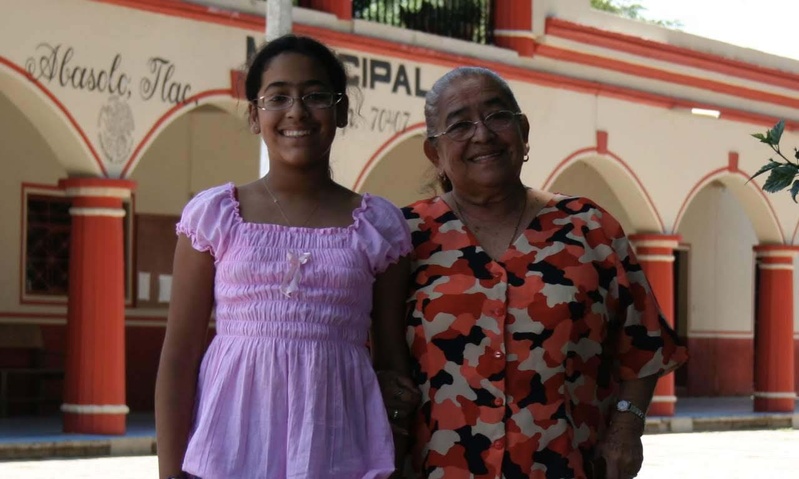My name is Jumko Ogata and until about a year ago I didn’t know the term Nikkei. Since I was a child, my grandmother had told me stories about her father, an immigrant named Jimpei Ogata (when he was baptized as a Catholic, he added the name Mariano), who came to Mexico to work in the coal mines. But because of his daily experience of inhuman conditions deep inside the earth, he decided to escape in search of a better life.
After several years he landed in Otatitlán, Veracruz, also known as Santuario del Cristo Negro. There he met Lupe Aguilar, a young woman who had been orphaned, and they married and raised a family with seven children. However, he never wanted to teach his children the Japanese language, nor did he speak to them about the family and the traditions he'd left behind. We knew very little about him, just a few small details that my grandmother and her siblings heard during his conversations with friends, or when he occasionally shared stories with my great-grandmother. On the day my grandmother was born, he took her to the civil registry office and when he returned, my great-grandmother asked him:
– Mariano, what did you name the girl?
– Namiko…that’s the name of the girlfriend I left in Japan.
– How dare you! Really...
To which he answered: “But why does that bother you? That was a long time ago and I'll never see her again...”
The only legacy from Japan that he left for his descendants was a list of Japanese names, so that their sons and daughters would carry on something from his native country. That list included the name of my aunt, Jumko Gabriela, and in her honor, my name as well: Jumko, just like that. Throughout my childhood, my name and last name were the only indications of my Japanese heritage, since I didn't speak the language, I wasn’t familiar with the traditions and even in terms of my physical appearance it was impossible to discern that part of my ancestry.
It wasn’t until I attended university that I decided to do some more research. By entering the field of history, I acquired the skills to find out more about his life and the conditions under which he arrived in Mexico. After attending several lectures by experts on the topic, I found information that seemed to be useful: the National Archives contained records of all foreigners residing in Mexico since the late 19th century and it was likely that his documents were among them. I searched the archive database and found a document that coincided with his information. All I needed to do now was go in person and see for myself.
I made the appointment and arrived soon afterward; I don’t know if my hands shook because of the cold winter wind that morning or my nervousness at the possibility of finding out more about him. Getting access to the record seemed endless; there were several screenings, and I had to provide different types of identification and leave my backpack in an assigned locker. Finally I arrived at the inquiries area, and they asked me to sit down while they pulled the record.
– Jumko Ogata…Yes, look, here it is, please check to make sure it's the right one and then you can go to the inquiries table…
I took the small envelope they handed to me with latex gloves to protect the old paper, and opened it not knowing what to expect. The first thing I saw was two photos of a man's profile. I was so surprised at this unexpected sight that I felt a knot in my throat. I thanked the archive employee and sat down at the inquiries table, trying to hold back tears in the middle of that huge room, knowing that a key part of my history was in that envelope in front of me.
Once I calmed down, I opened the envelope again and carefully read all of the contents. There was a single page that said that Mariano Jimpei Ogata, originally from Miyako, Okinawa, had arrived in the port of Salina Cruz, Oaxaca, on June 17, 1907, that he was 1.59 meters tall, with brown eyes and a mustache. There were some other general pieces of information, the two photos I had seen and at the bottom, his signature, written in his own handwriting.
And right away, everything my grandmother had told me about him took on a new meaning, since now they weren’t just stories about a distant ancestor, but he was someone with a face that I could attribute everything to: the man who watched carts carry bodies out of the mines, who was almost shot to death during the Revolution by mistake, the starving man who was released from prison after his incarceration for being Japanese during World War II. That’s when I knew that I wanted to continue researching him, and that I would write my thesis on that topic.
I continued to do archival and oral history research to compile the experiences of other Nikkei like myself, since my great-grandfather wasn't the only Japanese person to arrive in Otatitlán. I was able to help others learn about their ancestry and the stories of their forebears, even though they themselves had shared little about their lives.
I feel Nikkei when I write the stories of those who couldn’t tell them, by recording the memories of them held by their children and grandchildren. This ensures that they are not forgotten, at least within their families.
© 2018 Jumko Ogata Aguilar





